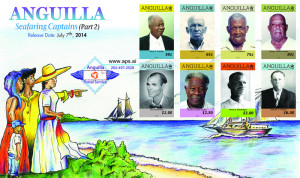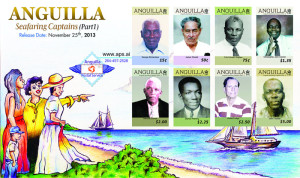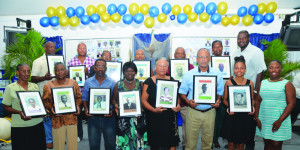
Minister Evan Gumbs (Back row, far right)
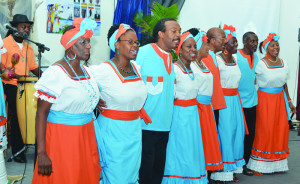
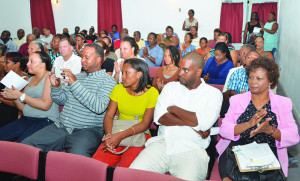
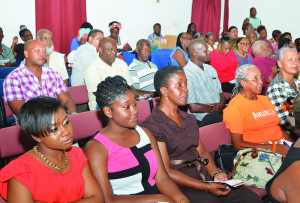
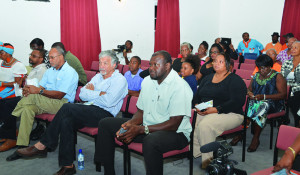 The Anguilla Seafaring Captains issue of postage stamps (Part 1 & Part 2) may be the most significant set of stamps to be printed, depicting an important part of the history of the island, since the 1967 overprint of stamps marked Independent Anguilla.
The Anguilla Seafaring Captains issue of postage stamps (Part 1 & Part 2) may be the most significant set of stamps to be printed, depicting an important part of the history of the island, since the 1967 overprint of stamps marked Independent Anguilla.
Part 1 was released in November last year and Part 2 has just been released. The twin issue, in honour of the outstanding contribution of sixteen selected Anguillian boat captains, was launched at an official unveiling ceremony held at the Teachers’ Resource Centre on Monday evening, July 7. The event was chaired by Mr Karim Hodge, Director of the Department of Environment.
The new postage stamps are the joint creation of the General Post Office, the Anguilla Philatelic Bureau and the Anguilla Stamp Advisory Committee.
The Teachers’ Resource Centre was filled to capacity by invited guests, among them being the proud relatives of the seafaring captains. The industry of these captains has largely distinguished Anguilla from the more prosperous islands, and has been a distinguishing factor in the way of life on the island and its development.
In giving the welcome remarks, Deputy Postmaster, Mrs Marcia Richardson, said the Stamp Advisory Committee thought it appropriate and timely to recognise and pay tribute to the seafaring Anguillian men of yesteryear. According to her, the s eafares had “unselfishly ploughed the turbulent seas, with limited navigational resources to help lay the foundation in which Anguilla’s economy now thrives.”
The Postmaster, Mrs Jacqueline Bryan-Niles, said in part: “Anguilla Seafaring Captains (Part 1 & Part 2) is not merely a collection of stamps but, more importantly, is an educational and historical reflection and journey into the very eventful past of the Anguilla of yesteryear. Through the miniature postage stamp our seafaring captains can now circle the globe via air, and millions are afforded the opportunity to learn a little of our history and customs through this unique medium – our postage stamps.
“It is virtually impossible to speak of a sea captain and his travels without mentioning his ship or vessel. Therefore, in 2003 the Anguilla Philatelic Bureau, in collaboration with the Anguilla Stamp Advisory Committee, commissioned the production of a new definitive stamp issue – Past Sailing Vessels of Anguilla which now complements the unveiling this evening of Anguilla Seafaring Captains (Part 1 & Part 2).”
Acting Chief Minister, Evan Gumbs, said the ceremony was a reminder that Anguillians should always be proud of their heritage. “It is that heritage that has allowed us to develop into the modern developed nation that we are today,” he stated. “Anguilla had a community of great seamen who connected Anguilla predominantly with the Caribbean region. These seamen were led by fiercely dedicated, nationalistic and unselfish seafaring captains.”
The Minister said that the ill-equipped captains “persevered through storms and rough seas to transport Anguillian workers to and from abroad and bring supplies to the island. They carried abroad our dried peas, brooms, salt, mauby bark and whatever we could find to export. They were tragedies as well, and I pause to remember all those great seamen and women who lost their lives on Anguillian vessels over the years.”
Mr Gumbs commended all concerned for having the foresight to produce such an inspiring stamp edition.
His remarks were followed by an intermission during which the Myoumba Folkloric Theatre presented a series of songs and dances which portrayed the early cultural life and customs of the people of Anguilla. Earlier also, there was the recitation of a poem written by Mrs Patricia Adams entitled Captain, Good Captain.
The feature address was delivered by historian and boat-builder, Mr David Carty, who has a fascination with boating in Anguilla and the life of seafarers “who have the sea in their blood”. He said it was very important to examine the history of the island, before the Anguilla Revolution, to discover the foundation on which the way of life in the past, had helped to shape the future of Anguilla and its people.
He stated that it was important to consider what the seafaring captains, “and so many others who lie in unmarked graves, contributed to our little rock.” He stressed that, in order to understand that better, there was a need “to turn the clock way back before these men were born – back to 1825” when Anguilla was faced with a very hard life, compared with the more prosperous islands. It was out of that situation that enterprising Anguillians began their boatbuilding industry to eke out a means of livelihood for themselves and to establish a way of life for Anguilla.
“Today, a little society like ours survived by these craftsmen and fearless mariners and that we must respect and honour,” Mr Carty said. His colourful presentation included a number of tragic, as well as humorous, stories which added much to the otherwise important contribution of the seafaring captains to the boatbuilding trade, shipping and the development of Anguilla.
Mr Carty joined in commending the Post Office, the Philatelic Bureau and the Stamp Advisory Committee for coming up with the idea of the Anguilla Seafaring Captains (Part 1 & Part 2) issue of postage stamps.
His address was followed by presentations of framed photographs of the sixteen Seafaring Captains to their relatives by Minister Evan Gumbs assisted by Miss Ashona Desouza.
Rev Dr Wycherley Gumbs, who delivered the invocation at the commencement of the ceremony, gave a roll call of the names of some thirty or more seafarers. It was noted that all of them had contributed greatly to Anguilla, although they were not among the captains who were honoured on the postage stamps.
The ceremony closed with members of the audience being given an opportunity to briefly speak about a deceased or living seafaring captain.

